The Hikari Railstar on the Sanyo Shinkansen
By Anthony Robins
Although airline deregulation in Japan has not yet developed to
anywhere
near the extent that it has in Europe or the US, it has started and
promises to increase. One key shinkansen route under increased
competitive pressure is the Sanyo Shinkansen between Shin-Osaka and
Hakata (the terminal in Fukuoka). One response to this is JR West's
introduction of the 'Hikari Railstar'.
Introduced from 11th March and increased to a full eighteen return
workings from 22nd April, the eight-car type 700 used offers a top
speed of 285 kph, allowing journeys from Shin-Osaka to Hiroshima in an
average 91 minutes and to Fukuoka in an average 165 minutes.
The sets' grey and black livery with yellow bodystripe gives them a
markedly different appearance to the first 700s in traditional white
and blue bullettrain livery used on many 'Nozomi' services. In
addition, they introduce several innovations. On the one hand, maximum
capacity is achieved by the absence of green car (first class)
vehicles. On the other hand, compartments offer four people privacy at
no extra cost, although a
supplement is added when only two or three use them. Cars 5 to 8 offer
'office seats' with laptop friendly tables and sockets, while car 7
provides 'barrier-free' provision for disabled passengers. A plethora
of
announcements is a feature of travel by train in Japan, but the
'silence
car' (car 4) is uncannily quiet, with no announcements and seat back
ticket holders to enable unobtrusive ticket inspection. A first is
touch screen timetable information and the 'Rail Star' sets follow
other recent bullet trains in limiting catering to trolley service and
vending machines.
Vital statistics for the sets are a capacity of 571 passengers in five
non-smoking and three smoking cars. Maximum length is 273.5 metres (end
cars) and 250 metres (intermediate cars), height is 3.65 metres and width is 3.38 metres.
Early loadings have been high. In the first month of operation (from
11th March), loadings on the 'Hikari Railstar' averaged 101%. However,
this was partly at the expense of both faster 'Nozomi' and slower
'Kodama' services. Their entrance into service particularly highlights
the age of remaining '0' series sets still in use on the same section
of the shinkansen and the contrast is shown in accompanying images at
Shin-Osaka.
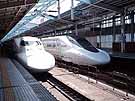
Contrasting liveries are shown with Type 700 on 'Nozomi 7'
awaiting departure at 1128 for Hakata. 'Rail Star' waits alongside,
having formed the 1122 arrival from Hakata (Hikari 362), before leaving
empty stock.
|

'Kodama 614', the first to leave Hakata (at 0608), shortly after arrival at Shin-Osaka at 1103.
|

'Rail Star' set E4 awaits departure for Hakata on the 1058 'Hikari 367'
service.
|
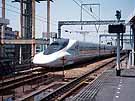
'Rail Star' set leaves Shin-Osaka on the 1058 'Hikari 367' service for Hakata, with arrival there at 1341.
|
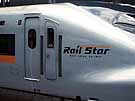
Close-up of the leading car, showing set number (E9) and 'Rail Star' branding.
|
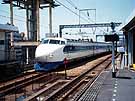
'Kodama 614' approaches the platform used for terminating Sanyo Shinkansen services at Shin-Osaka.
|
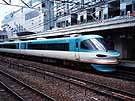
With the modern Kyoto Station building behind it, type 283 on
'Ocean Arrow 17' stands at the platform awaiting departure for Shingu.
|
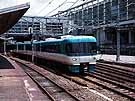
Type 283 leaves Kyoto towards Osaka at 1235 on the first leg of its four hour journey to Shingu.
|

Having arrived on a 'Kodama' working from Tokyo, a type 100 negotiates the route into the car sheds just beyond Shin-Osaka.
|
[Home Page]








